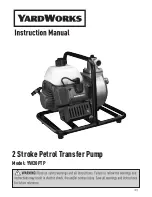
7
Figure 2 shows a typical connection for 1 phase 120 volt
pumps with a piggy-back plug, for manual and automatic
operations.
General Comments:
1) Never work in the sump with the power on.
2) Level controls are factory set for a pumping differential of 9
inches. If that is the cycle desired, simply circle the discharge
pipe with the pipe mounting strap, feed the end through the
worm drive, and tighten with a screwdriver. Be certain that the
level control cannot hang up or foul in it’s swing. Also, make
certain the top of the pump is still submerged when the level
control is in the ‘off’ mode.
3) If a higher pump differential is needed, grip the cord near
the neck of the float, then using the other hand, exert a
steady force on the lower edge of the cable clamp. The cable
clamp should slide up to the new pivot point. Attach the level
control to the discharge hose in the manner described above.
4) Plug the level control plug into the receptacle, then plug
the pump into the piggyback plug. One cycle of operation
should be observed, so that any potential problems can be
corrected.
5) It is recommended that the float should be set to insure
that the sump well liquid level never drops below the top of
the motor housing.
6.) Figure 3 shows a typical connection for pumps with
the wide angle float and piggy-back plug. For manual and
automatic operations.
Automatic - Plug float cord into outlet, then plug pump
cord into float cord.
Manual - Plug pump cord directly into outlet
C-4) Electrical Connections:
An acceptable motor control switch shall be provided at the
time of installation.
C-4.1) Power and Control Cable:
The cord assembly mounted to the pump must not be
modified in any way except for shortening to a specific
application. Any splice between the pump and the control
panel must be made in accordance with all applicable electric
codes. It is recommended that a junction box, if used, be
mounted outside the sump or be of at least Nema 4 (EEMAC-4)
construction if located within the wet well.
Do not use the
er or control cable to lift pump.
NOTE: The white wire
is NOT a neutral or ground lead, but a power carrying
conductor.
C-4.2) Overload Protection :
C-4.2-1) Three Phase (Optional) -
The normally closed
(N/C) thermal sensor is embedded in the motor windings and
will detect excessive heat in the event an overload condition
occurs. The thermal sensor will trip when the windings
become too hot and will automatically reset itself when the
pump motor cools to a safe temperature. It is recommended
that the thermal sensor be connected in series to an alarm
device to alert the operator of an overload condition, and/
or the motor starter coil to stop the pump. In the event of an
Automatic
Manual
120 Volt 1 Phase
Automatic
Manual
240 Volt 1 Phase
FIGURE 3
TYPICAL INSTALLATION WITH WIDE ANGLE
LEVEL CONTROL
FIGURE 2
Summary of Contents for Barnes DS Series
Page 15: ...15 FIGURE 15 CONTIUED ...
Page 17: ...17 FIGURE 16 EH L Series Single Seal ...
Page 18: ...18 FIGURE 17 EH L Series Single Seal Used with Cast Iron Impeller 33 ...
Page 19: ...19 FIGURE 18 EH DS Series Double Seal ...
Page 20: ...20 FIGURE 19 EH DS Series Double Seal 66 USED WITH CAST IRON IMPELLER 33 ...
Page 23: ...23 Notes ...
Page 24: ...24 Notes ...








































